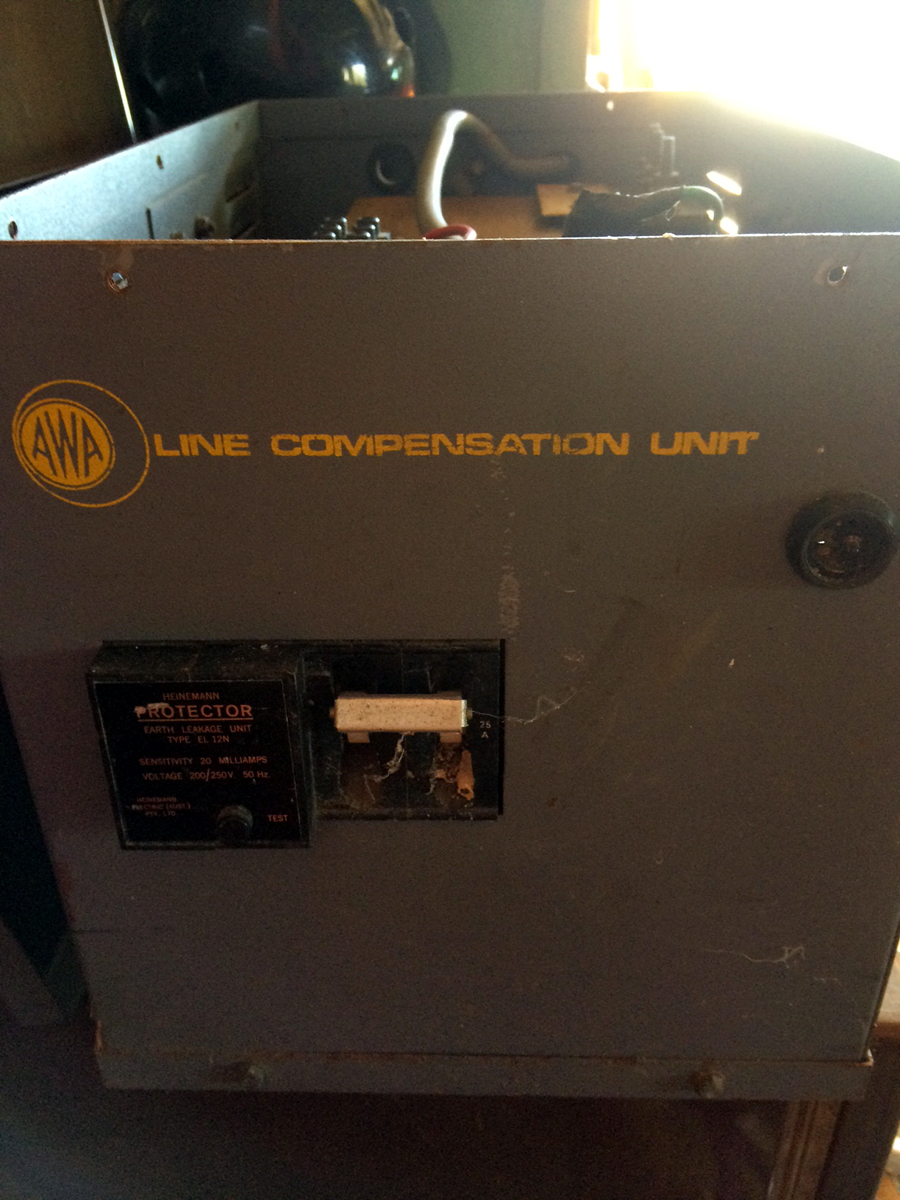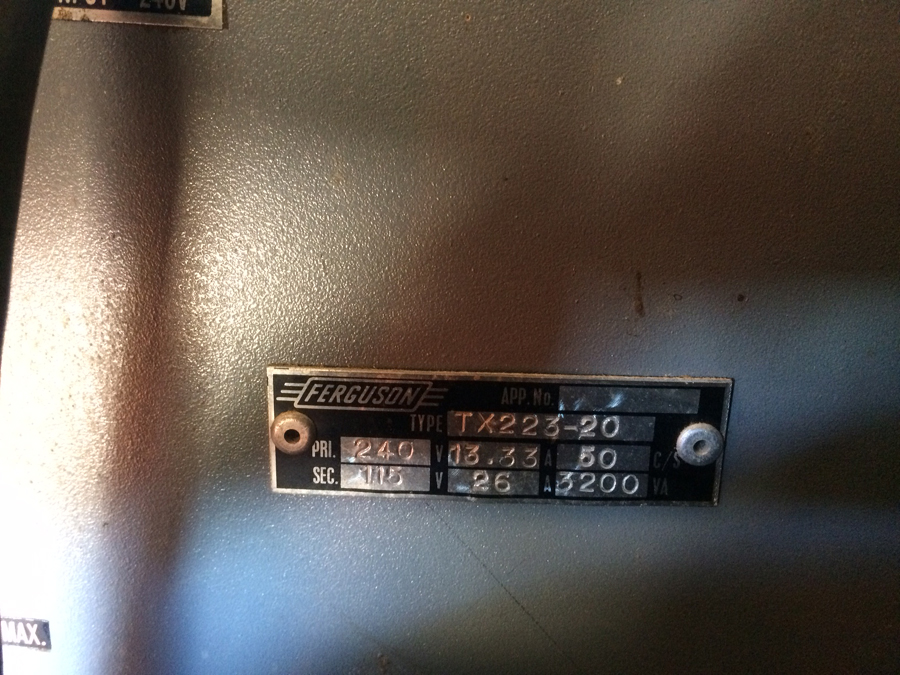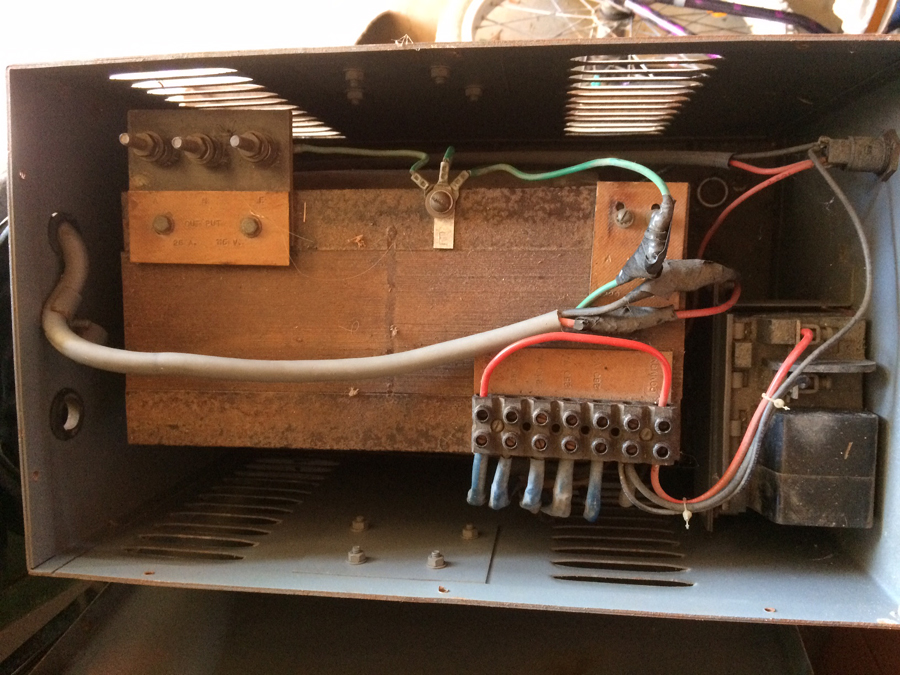General Discussion
Forum home - Go back to General discussion
|
AWA line compensation unit. What is it for?
|
|
|
Return to top of page · Post #: 1 · Written at 1:46:55 PM on 13 May 2018.
|
|
|
|
Location: Maleny, QLD
Member since 28 February 2018 Member #: 2218 Postcount: 95 |
|
Hi, all. I wonder if anyone knows why this may have been used for? It is excess to my requirements, and I might be able to move it on gumtree etc, if only I knew it’s intended use. Or perhaps it is better sent to the scrap metal man? It transforms 240 volt to 115, about 2900 watt I think. It would suit American tools etc in Australia, although its outlet (I think) is an Aussie type plug.    |
|
|
Return to top of page · Post #: 2 · Written at 3:55:43 PM on 13 May 2018.
|
|
|
|
Location: Wangaratta, VIC
Member since 21 February 2009 Member #: 438 Postcount: 5595 |
|
There is quite a bit of 110-115V equipment about. Make sure its a transformer & not an "auto-transformer. I have one of both. One can be used for isolation, auto transformer: No. |
|
|
Return to top of page · Post #: 3 · Written at 5:54:36 PM on 13 May 2018.
|
|
|
|
Location: Sydney, NSW
Member since 28 January 2011 Member #: 823 Postcount: 6882 |
|
It would suit American tools etc in Australia |
|
|
Return to top of page · Post #: 4 · Written at 8:15:32 PM on 13 May 2018.
|
|
|
|
Location: Maleny, QLD
Member since 28 February 2018 Member #: 2218 Postcount: 95 |
|
Good point, I didn’t consider it being 50Hz. I will need to look harder, but it seems to have varying voltage “taps” coming off the winding, this might suggest auto transformer? Is this similar to a variac in principle? |
|
|
Return to top of page · Post #: 5 · Written at 8:26:21 PM on 13 May 2018.
|
|
|
|
Administrator
Location: Naremburn, NSW
Member since 15 November 2005 Member #: 1 Postcount: 7548 |
|
Isolation transformers can have tappings too. The only way to find out is to put an ohm meter across one of the primary terminals and one of the secondary terminals. If there is continuity then it is not an isolation transformer. ‾‾‾‾‾‾‾‾‾‾‾‾‾‾‾‾‾‾‾‾‾‾‾‾‾‾‾‾‾‾‾‾‾‾‾‾‾‾‾‾‾‾‾‾‾‾‾‾‾‾‾‾‾‾‾‾‾‾‾‾‾‾‾‾‾‾‾‾ A valve a day keeps the transistor away... |
|
|
Return to top of page · Post #: 6 · Written at 9:19:17 PM on 13 May 2018.
|
|
|
|
Location: Sydney, NSW
Member since 28 January 2011 Member #: 823 Postcount: 6882 |
|
A good in-focus photo or two may help. |
|
|
Return to top of page · Post #: 7 · Written at 10:05:36 PM on 13 May 2018.
|
|
|
|
Location: Wangaratta, VIC
Member since 21 February 2009 Member #: 438 Postcount: 5595 |
|
The ring tone in the old phones was 110VAC. So it is possible that it is like the transformer in the VCT Valve & Circuit tester, which has a switched set of tappings , that, with the aid of the meter, sets the operating voltage so that all tests are at the same voltage. |
|
|
Return to top of page · Post #: 8 · Written at 2:23:33 PM on 14 May 2018.
|
|
|
|
Location: Darlington, WA
Member since 30 March 2016 Member #: 1897 Postcount: 192 |
|
Would never have been anything to do with phone ringing current as that was almost always generated by specially made generator units that provided 75V AC |
|
|
Return to top of page · Post #: 9 · Written at 6:21:00 PM on 14 May 2018.
|
|
|
|
Location: Belrose, NSW
Member since 31 December 2015 Member #: 1844 Postcount: 2629 |
|
It's nothing to do with AC mains power. |
|
|
Return to top of page · Post #: 10 · Written at 8:00:22 PM on 14 May 2018.
|
|
|
|
Location: Linton, VIC
Member since 30 December 2016 Member #: 2028 Postcount: 472 |
|
As an "Installer" with Telecom Australia I visited many exchanges and remember the Ring Tone gennys very well. |
|
|
Return to top of page · Post #: 11 · Written at 10:12:12 PM on 14 May 2018.
|
|
|
|
Location: Sydney, NSW
Member since 28 January 2011 Member #: 823 Postcount: 6882 |
|
For some reason I found them rather hypnotic, and could watch them operating for lengthy periods. |
|
|
Return to top of page · Post #: 12 · Written at 10:31:18 PM on 14 May 2018.
|
|
|
|
Location: Linton, VIC
Member since 30 December 2016 Member #: 2028 Postcount: 472 |
|
Nice one, many thanks GTC. |
|
|
Return to top of page · Post #: 13 · Written at 6:54:34 PM on 15 May 2018.
|
|
|
|
Location: Darlington, WA
Member since 30 March 2016 Member #: 1897 Postcount: 192 |
|
Interesting to see those ringing machines going on the couple of YouTube clips. |
|
|
Return to top of page · Post #: 14 · Written at 7:26:12 PM on 15 May 2018.
|
|
|
|
Location: Sydney, NSW
Member since 28 January 2011 Member #: 823 Postcount: 6882 |
|
Thanks. That's the best description of the operation of mechanical ring generators that I've ever read. |
|
|
Return to top of page · Post #: 15 · Written at 7:45:26 PM on 15 May 2018.
|
|

|
Location: Nildottie, SA
Member since 7 April 2018 Member #: 2236 Postcount: 43 |
|
Thanks for the references to the step X step exchanges. I started with Telecom (1970s) in Unley exchange containing pre2000 (strowger),2000 and Xbar. |
|
|
You need to be a member to post comments on this forum.
|
|

Sign In

Vintage Radio and Television is proudly brought to you by an era where things were built with pride and made to last.
DISCLAIMER: Valve radios and televisions contain voltages that can deliver lethal shocks. You should not attempt to work on a valve radio or other electrical appliances unless you know exactly what you are doing and have gained some experience with electronics and working around high voltages. The owner, administrators and staff of Vintage Radio & Television will accept no liability for any damage, injury or loss of life that comes as a result of your use or mis-use of information on this website. Please read our Safety Warning before using this website.
WARNING: Under no circumstances should you ever apply power to a vintage radio, television or other electrical appliance you have acquired without first having it checked and serviced by an experienced person. Also, at no time should any appliance be connected to an electricity supply if the power cord is damaged. If in doubt, do not apply power.
Shintara - Keepin' It Real · VileSilencer - Maintain The Rage

 16.666Hz. That was used to ring the magneto bells in the phones.
16.666Hz. That was used to ring the magneto bells in the phones.